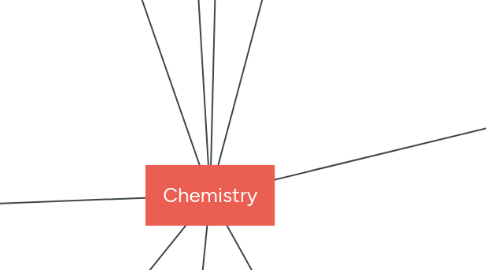
1. Elements
1.1. Characteristics
1.1.1. Colour
1.1.2. Brittle
1.1.3. Melting & boiling points
1.1.3.1. Mercury
1.1.4. Density
1.1.5. State
1.1.6. Chemical Reactions
2. Periodic Table
2.1. Dimitri Mendeelev
2.2. Metals
2.2.1. Solid at Room Temperatures
2.2.2. Polished
2.2.3. Good Conducters
2.2.4. Malleable
2.2.5. Ductile
2.2.6. Melt
2.2.6.1. High temperatures
2.3. Non-metals
2.3.1. Cannot be polished
2.3.2. brittle
2.3.3. non-malleable
2.3.4. poor conducters
2.3.5. Melt
2.3.5.1. Low temperatures
2.3.6. Examples
2.3.6.1. Sulfur
2.3.6.2. Carbon
2.3.6.3. Oxygen
2.4. Metalloids
2.4.1. Characteristics
2.4.1.1. Metals
2.4.1.2. Non-metals
2.4.2. Examples
2.4.2.1. Boron
2.4.2.2. Arsenic
2.4.2.3. Polonium
2.4.2.4. Astatine
2.4.2.5. Tellurium
3. Compounds
3.1. Sodium
3.1.1. Chlorine
3.1.1.1. Sodium chlorine
3.2. Seperation methods
3.2.1. Passing Electricity
3.2.2. Burning
3.2.3. Mixing with acids
4. Molecules
4.1. Ball and Stick models
4.1.1. Atoms joined in groups
4.1.1.1. Hydrogen
4.1.1.2. Carbon
4.1.1.3. Oxygen
4.1.1.4. Sulfur
4.1.1.5. Chlorine
4.1.1.6. Nitrogen
4.2. Non-molecules
4.2.1. Lattice
4.3. René Descartes
4.3.1. Water Molecule
4.3.1.1. Oxygen
4.3.1.2. 2 Hydrogen
5. Polymers
5.1. Many
5.2. Long identical molecules
5.2.1. Small identical molecules
5.2.1.1. Monomers
5.3. Types
5.3.1. Synthetic
5.3.1.1. Polynamade
5.3.1.1.1. Nylon
5.3.1.2. Polyethelene
5.3.1.2.1. Ethelene
5.3.1.3. Polyvinyl chloride
5.3.1.3.1. Drainage pipes
5.3.2. Natural
5.3.2.1. Polymer Cellulose
5.3.2.1.1. Paper
5.3.2.2. Silk
5.3.2.2.1. Silk Worms
5.3.2.3. Nucluic Acid
5.3.2.3.1. DNA
5.3.2.4. Keratin
5.3.2.4.1. Finger nails
6. History of Atom
6.1. Matter
6.2. Tunneling Electron Microscope
6.3. Democritis
6.3.1. Greek
6.3.2. 2500 years
6.3.3. Atomos
6.3.3.1. Unbreakable
6.4. 19th Century
6.4.1. John Dalton
6.4.1.1. Pioneer
6.4.1.2. Theories
6.4.1.2.1. Matter made up of atoms
6.4.1.2.2. All atoms in an element is identical
6.4.1.2.3. different atoms have differnt masses and chemical properties
6.4.1.2.4. different atoms of different elements form compound
6.4.1.2.5. Cannot be created or destroyed
6.4.2. J.J Thompson
6.4.2.1. A glow when electricity passed through
6.4.2.1.1. Corpuscles
6.4.2.2. negative charge
6.4.2.3. Positive charge
6.4.3. Ernst Ruthford
6.4.3.1. Planetary model
6.4.3.1.1. Positive charge
6.4.3.1.2. mostly empty
6.4.3.1.3. Negative charge
6.4.4. Neils Bohr
6.4.4.1. Nucleus
6.4.4.2. Electron Clouds
6.4.5. James Chadwick
6.4.5.1. Nucleus
6.4.5.1.1. Electrons
6.4.5.2. Around Nucleus
6.4.5.2.1. Negative charge
7. Structure of Atom
7.1. Protons
7.1.1. Nucleus
7.1.1.1. Heavy
7.1.1.1.1. Positive
7.2. Neutrons
7.2.1. Nucleus
7.2.1.1. Heavy
7.2.1.1.1. Neutral
7.3. Electrons
7.3.1. Around nucleus
7.3.1.1. Light
7.3.1.1.1. Negative
7.4. Empty Space
7.5. 118
7.6. Nucleus
7.6.1. Nucleons
8. Alloys
8.1. Melting
8.1.1. Combined
8.1.1.1. Mixing
8.1.1.1.1. Mixture
9. Carbon
9.1. TYPES OF CARBON
9.1.1. Diamond
9.1.2. Graphite
9.1.3. Armorphous
9.2. Allatropes
9.2.1. differnt appearances
9.2.2. Properties
9.3. First Element
9.3.1. Alchemists
9.4. Concentrated Sulfric Acid
9.4.1. Carbon in sugar
9.5. Carbon Atoms
9.5.1. Air
9.5.1.1. Respiration
9.5.1.2. Decomposition
9.5.1.3. Burning

